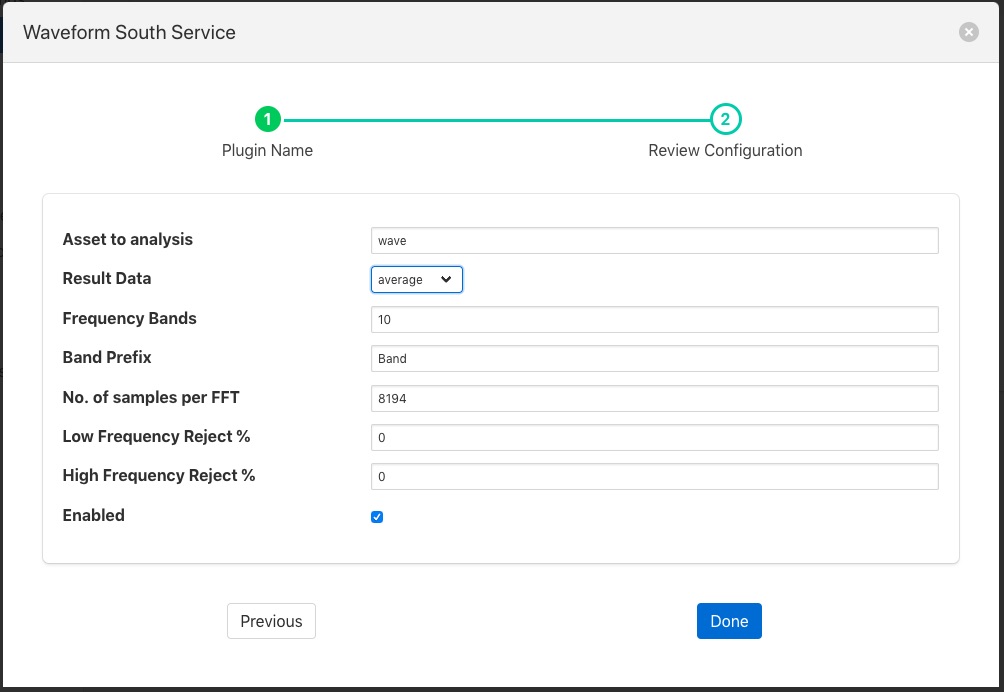Fast Fourier Transform Filter¶
The foglamp-filter-fft filter is designed to accept some periodic data such as a sample electrical waveform, audio data or vibration data and perform a Fast Fourier Transform on that data to supply frequency data about that waveform.
Data is added as a new asset which is named as the sampled asset with ” FFT” append. This FFT asset contains a set of data points that each represent the a band of frequencies, or as a frequency spectrum in a single array data point. The band information that is returned by the filter can be chosen by the user. The options available to represent each band are;
the average in the band,
the peak
the RMS
or the sum of the band.
The bands are created by dividing the frequency space into a number of equal ranges after first applying a low and high frequency filter to discard a percentage of the low and high frequency results. The bands are not created if the user instead opts to return the frequency spectrum.
If the low Pass filter is set to 15% and the high Pass filter is set to 10%, with the number of bands set to 5, the lower 15% of results are discarded and the upper 10% are discarded. The remaining 75% of readings are then divided into 5 equal bands, each of which representing 15% of the original result space. The results within each of the 15% bands are then averaged to produce a result for the frequency band.
FFT filters are added in the same way as any other filters.
Click on the Applications add icon for your service or task.
Select the fft plugin from the list of available plugins.
Name your FFT filter.
Click Next and you will be presented with the following configuration page
|
Configure your FFT filter
Asset to analysis: The name of the asset that will be used as the input to the FFT algorithm.
Result Data: The data that should be returned for each band. This may be one of average, sum, peak, rms or spectrum. Selecting average will return the average amplitude within the band, sum returns the sum of all amplitudes within the frequency band, peak the greatest amplitude and rms the root mean square of the amplitudes within the band. Setting the output type to be spectrum will result in the full FFT spectrum data being written. Spectrum data however can not be sent to all north destinations as it is not supported natively on all the systems FogLAMP can send data to.
Frequency Bands: The number of frequency bands to divide the resultant FFT output into
Band Prefix: The prefix to add to the data point names for each band in the output
No. of Samples per FFT: The number of input samples to use. This must be a power of 2.
Low Frequency Reject %: A percentage of low frequencies to discard, effectively reducing the range of frequencies to examine
High Frequency Reject %: A percentage of high frequencies to discard, effectively reducing the range of frequencies to examine
See Also¶
foglamp-filter-ADM_LD_prediction - Filter to detect whether a large discharge is required for a centrifuge
foglamp-filter-asset-conformance - A plugin for performing basic sanity checking on the data flowing in the pipeline.
foglamp-filter-asset-validation - A plugin for performing basic sanity checking on the data flowing in the pipeline.
foglamp-filter-batch-label - A filter to attach batch labels to the data. Batch numbers are updated based on conditions seen in the data stream.
foglamp-filter-breakover - Filter to forecast the a pending breakover event in a centrifuge.
foglamp-filter-conditional-labeling - Attach labels to the reading data based on a set of expressions matched against the data stream.
foglamp-filter-ednahint - A hint filter for controlling how data is written using the eDNA north plugin to AVEVA’s eDNA historian
foglamp-filter-enumeration - A filter to map between symbolic names and numeric values in a datapoint.
foglamp-filter-expression - A FogLAMP processing filter plugin that applies a user define formula to the data as it passes through the filter
foglamp-filter-inventory - A plugin that can inventory the data that flows through a FogLAMP pipeline.
foglamp-filter-log - A FogLAMP filter that converts the readings data to a logarithmic scale. This is the example filter used in the plugin developers guide.
foglamp-filter-metadata - A FogLAMP processing filter plugin that adds metadata to the readings in the data stream
foglamp-filter-normalise - Normalise the timestamps of all readings that pass through the filter. This allows data collected at different rate or with skewed timestamps to be directly compared.
foglamp-filter-omfhint - A filter plugin that allows data to be added to assets that will provide extra information to the OMF north plugin.
foglamp-filter-python35 - A FogLAMP processing filter that allows Python 3 code to be run on each sensor value.
foglamp-filter-rms - A FogLAMP processing filter plugin that calculates RMS value for sensor data
foglamp-filter-scale - A FogLAMP processing filter plugin that applies an offset and scale factor to the data
foglamp-filter-scale-set - A FogLAMP processing filter plugin that applies a set of sale factors to the data
foglamp-filter-sigmacleanse - A data cleansing plugin that removes data that differs from the mean value by more than x sigma
foglamp-filter-specgram - FogLAMP filter to generate spectrogram images for vibration data
foglamp-filter-statistics - Generic statistics filter for FogLAMP data that supports the generation of mean, mode, median, minimum, maximum, standard deviation and variance.
foglamp-filter-vibration_features - A filter plugin that takes a stream of vibration data and generates a set of features that characterise that data
foglamp-south-Expression - A FogLAMP south plugin that uses a user define expression to generate data
foglamp-south-digiducer - South plugin for the Digiducer 333D01 vibration sensor
foglamp-south-dt9837 - A south plugin for the Data Translation DT9837 Series DAQ

